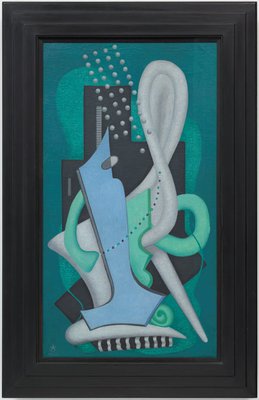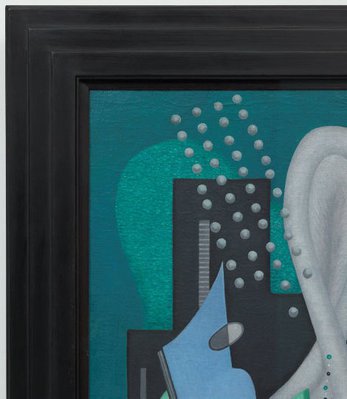


-
Details
- Date
- circa 1931
- Media category
- Painting
- Materials used
- oil on canvas
- Dimensions
- 88.0 x 48.0 cm
- Signature & date
Signed l.l. '‘Power’ and with artist’s monogram. Not dated.
- Credit
- Purchased with funds provided by the Australian Art Collection Benefactors and Patrick White Bequest 2020
- Location
- South Building, ground level, 20th-century galleries
- Accession number
- 148.2020
- Copyright
- Artist information
-
John Joseph Wardell Power
Works in the collection
- Share
-
-
About
The Sydney-born John Wardell Power left Australia a surgeon in 1906, but after two decades of a successful medical career in London, he made the decision to swap medicine for modern art. His studentship in Paris during the 1920s laid the foundation for his development of a distinct abstract language that flourished amidst his connections to the avant-garde in the cultural centres of London, Paris and Brussels during the interwar years.
In the 1920s, Power studied in the Paris atelier of the Brazilian-born Pedro Luiz Correia de Araújo, whose instruction on the geometric systems of composition inspired notions of the correspondences of mathematical and metaphysical orders that underpinned the philosophies of 20th century abstraction. By 1922, Power was studying under Fernand Léger and Amédée Ozenfant at the Académie Moderne, placing him at the centre of avant-garde instruction in Paris. Power was directed in the principles of the Purist movement that Ozenfant had co-founded which encouraged cubist-like compositions with forms of clarified precision, resulting in works of strangely stilled atmospheres.
Conflating the influence of cubist geometries and the Purists’ surrealist subtexts, Power contributed to a new breed of biomorphic abstraction that emerged in London and Paris during the interwar years. Biomorphism expressed inner worlds, using uncanny shapes that were reminiscent of human or plant forms, or the microscopic make-up of organic matter and exuded their own peculiar energies. For Power, the appeal of such creativity may have stemmed from his earlier life in medicine, with its close focus on body parts, as well as his medical research in virus vaccines. Equipped with these ideas, from the late 1920s, Power created alluring compositions of interconnecting ‘things’ that are nearly familiar, but pleasingly distant and dreamlike in being.This enigmatic quality of Power’s work is evocatively demonstrated in Composition c.1931. Here, curving forms tangle with the angular; the arabesque mingles with the pointed, in a composition that expands on cubist structure to invoke the deep mysterious zones of the unconscious. Power’s connecting forms may allude to the dancing or sexually entwined figures that featured in earlier paintings, but they are also escape identification and instil a sense of strangeness. As a hybrid of organised and constructivist aesthetics, Power’s Composition is an alluring statement of inner worlds, imaging synthesised forms and unfurling movements that exude a motivating life force.
With his distinct language of biomorphic abstraction, Power established a considerable artistic reputation exhibiting in London, Paris and Brussels during the interwar period. In London, he was a member of the 7 & 5 Society and The London Group, both considered crucial to the development of abstraction in England. Living in Paris in the 1930s, and in a city considered the centre of abstraction in Europe, Power became a founding member of the Abstraction-Création group that brought together an internationally diverse set of artists including Wassily Kandinsky, Albert Gleizes, Marlow Moss, Piet Mondrian, Naum Gabo and Barbara Hepworth.
Power’s work, vitally fashioned from within the progressive movements of these cities was first seen in Australia when it featured in the now legendary 1939 Herald exhibition of French and British contemporary art, which introduced avant-garde modernism to local audiences. Power’s work was received as part of this revelation of the new for a generation of Australian artists who eagerly looked to the artistic models of Europe to inspire change in their own work.
-
Exhibition history
Shown in 2 exhibitions
Deutscher Fine Art, Australian art: colonial to contemporary 1780s-1990s, Deutscher Fine Art (Melbourne), Malvern, Aug 1996 -
20th-Century galleries, ground level (rehang), Art Gallery of New South Wales, Sydney, 20 Aug 2022–2023


